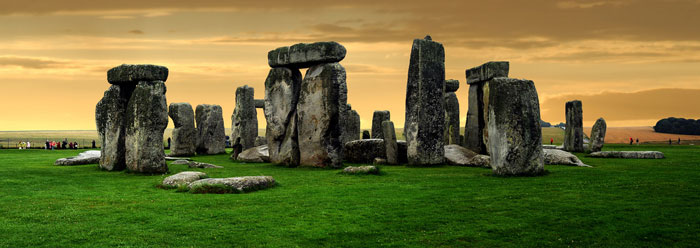Man-made geographical high points in southern England and Wales have been observed for centuries, including earthworks, stone monuments like Stonehenge, and hill camps. But something quite unexpected about their distribution may have been verified. When plotted from a bird’s-eye view, many of the ancient sites form corners of isosceles triangles in connection with other sites, making navigation a breeze for the ancients.
Tom Brooks, an amateur historian and retired executive, analyzed 1,500 of these sites. He found that they were laid out such that they formed triangles that have two sides with the same length. This would have enabled ancient travelers to pinpoint the direction and distance to the next location, or point on the triangle, using lines of sight to the hilltop markers, because “many were built within sight of each other and provided a simple way to get from A to B.”1
Brooks said, “Some of the triangles are over 100 miles across, yet the distances are accurate to within 100 metres. You cannot do that by chance. So advanced, sophisticated and accurate is the geometrical surveying now discovered, that we must review fundamentally the perception of our Stone Age forebears as primitive, or conclude that they received some form of external guidance.”1 Based on his observations, they would have had to be experts in spherical trigonometry to have marked out and used these triangular geographical patterns for navigation.
These observations and speculations fit perfectly with biblical history. It can be inferred from the biblical account of creation and the Fall that God made the first man as originally perfect, with his descendants gradually degrading over time as genetic corruption occurred. This directly contradicts the erroneous evolutionary concept that ancient man emerged from apes and had a lesser intellect than modern man—a concept also challenged by this new evidence of the mathematical brilliance of ancient British islanders.
Interestingly, a caveman illustration was added to this Daily Mail news item overnight. When the article was posted on September 14, no caveman was pictured, just the mapping and monument images. On September 15, however, the caveman appeared, as if to reinforce the evolutionary story, and a new title and URL were assigned to the article.2 The move on the editors’ part seems be an attempt to downplay this evidence of the genius of ancient Britons.
A new conclusion was also added to the updated story, apparently with a similar purpose:
However, Mike Pitts, editor of British Archaeology, said: 'The landscape of southern Britain was intensively settled and there are many earth works and archaeological finds. It is very easy to find patterns in the landscape, but it doesn't mean that they are real.'1
The patterns that Brooks found in the landscape, however, were not easy to find, not easy to have constructed, and not easy to have used without fully human faculties and mathematical knowledge. The complex configurations he discovered emerged from the monuments themselves, rather than from a preconceived pattern to which they were forced to conform. And Brooks is not the only author to have drawn similar conclusions.
Despite attempts to doctor the news to make it more evolution-friendly, ongoing scientific discoveries continue to document that ancient humans were as smart, if not smarter, than modern ones.3
References
- Derbyshire, D. Stone Age satnav: Did ancient man use 5,000-year-old travel chart to navigate across Britain. Daily Mail. Posted on dailymail.co.uk September 14, 2009 and updated September 15, 2009, accessed September 14, 2009 and September 15, 2009.
- The original title was “Ancient man used stone ‘sat nav’ 5,000 years ago to navigate across country.”
- See also Thomas, B. Ancient Stone Knives Made by ‘Smart’ Humans. ICR News. Posted on icr.org August 24, 2009.
* Mr. Thomas is Science Writer at the Institute for Creation Research.
Article posted on September 21, 2009.














